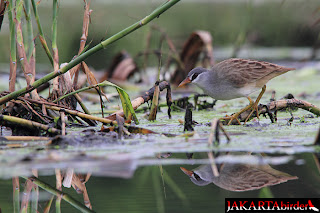Observer: Boas Emmanuel, Khaleb Yordan, and Andi Hartanto.
We
began our observation at 06.30PM, our main purpose is to find and count the
Black-winged Starling, and Javan Coucal numbers there. Both of them is a endemic species to Indonesia, and threatened
by habitat loss. Muara Angke Wildlife Sanctuary is their last stronghold in
Jakarta.
Now, there’s only few Water Hyacinth left at the main lake so it attracts the White-winged Terns, Lesser Whistling Ducks, and a pair of Sunda Teal. White-winged Tern usually sighted at the end of Angke River, and never been recorded inside Muara Angke Wildlife Sanctuary. While we observe them, the Black-winged Starling group were flying around the lake which make our counting easier.
At the water edges, we saw the Ruddy-breasted and White-browed Crake. Surprisingly, the White-browed is more territorial than its cousin. At the beginning it always drive the Ruddy to forage inside the grass which make us a little bit “desperate” because we afraid we won’t get any pictures of the Ruddy. But, that feel is gone when in the afternoon the White-browed finally share its feeding ground with its cousin. We learned that both of them feed on the same prey, I think that’s why the White-browed always chase the Ruddy. At the end of our observation, we don’t find any Javan Coucal but one of my friend saw it twice near the front office. Other highlight from this visit is Male Yellow-rumped Flycatcher, Purple-backed Starling, Black and Cinnamon Bittern..
Now, there’s only few Water Hyacinth left at the main lake so it attracts the White-winged Terns, Lesser Whistling Ducks, and a pair of Sunda Teal. White-winged Tern usually sighted at the end of Angke River, and never been recorded inside Muara Angke Wildlife Sanctuary. While we observe them, the Black-winged Starling group were flying around the lake which make our counting easier.
 |
| A couple of Lesser Whistling Duck. |
 |
| Lesser Whistling with a Water Hyacinth. |
 | |||||
| A couple of Lesser Whistling Duck. |
 |
| A pair of Sunda Teal. |
 |
| Small group of Lesser Whistling Duck. |
 |
| A couple of Lesser Whistling Duck. |
 |
| A big group of Lesser Whistling Duck. |
 |
| Lesser Whistling Duck Habitat. |
 | |
| A couple of Black-winged Starling in flight. PS: Sorry for the HALO effect. |
At the water edges, we saw the Ruddy-breasted and White-browed Crake. Surprisingly, the White-browed is more territorial than its cousin. At the beginning it always drive the Ruddy to forage inside the grass which make us a little bit “desperate” because we afraid we won’t get any pictures of the Ruddy. But, that feel is gone when in the afternoon the White-browed finally share its feeding ground with its cousin. We learned that both of them feed on the same prey, I think that’s why the White-browed always chase the Ruddy. At the end of our observation, we don’t find any Javan Coucal but one of my friend saw it twice near the front office. Other highlight from this visit is Male Yellow-rumped Flycatcher, Purple-backed Starling, Black and Cinnamon Bittern..
 |
| White-browed Crake prefers to foraging near the thick vegetation. |
 |
| White-browed Crake looking for Grub on a pile of dead water hyacinth |
 |
| Size comparison between White-browed Crake with a grass. |
 |
| White-browed Crake habitat. |
 |
| White-browed Crake is rarely comes into the open area like this. |
 |
| Adult Ruddy-breasted Crake. |
 |
| Just like its cousin, Ruddy-breasted Crake prefers to foraging near the thick vegetation. |
 |
| Ruddy-breasted Crake has the same prey like its cousin. |
 |
| Adult Ruddy-breasted Crake |
 |
| Adult Ruddy-breasted Crake |
 |
| Ruddy-breasted Crake habitat. |
 |
| Immature Ruddy-breasted Crake has a duller red color. |
 |
| Immature Ruddy-breasted Crake with a moulting feathers on its head. |
 | |
| Immature Ruddy-breasted Crake. |
 |
| Immature Ruddy-breasted Crake. |
 |
| Immature Ruddy-breasted Crake. |
 |
| Immature Ruddy-breasted Crake. |
Nice report ... i like that :)
ReplyDeleteThank you Mas Ady..
Deletenice bgt mas boas,
ReplyDelete:D
Terima kasih mas Dian..
DeleteNice Photo.
ReplyDeletethanks Mr. Roland.. :-)
Delete